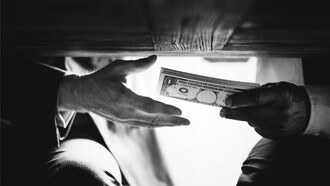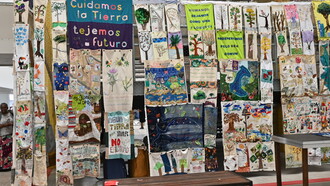From April 10 to 11, curators Martín Rentería and Geraldine Vignette bring together several performing artists in CDMX, but not all of them will be able to attend.
In the video Assembly Line (2024), the artist Xue Liu tells of the treatment he received upon arriving at passport control by the Mexican State Border Police. The artist had left Germany with the intention of participating in an ephemeral performance festival in the Zone of Silence in the state of Chihuahua, being officially invited and announced by the organizers of the event.
Xue LIU was denied entry to Mexico for not having a German visa affixed to his Chinese passport for residing in Germany for more than 5 years and having a plastic card instead of the sticker. The multiple formats that migrants carry today, like protective stamps, shields, and symbols on difficult-to-forge paper or plastic cards with RFID chips, holograms that give credit, no longer provide credit by themselves. They are the migrants who must act accordingly and build the corresponding identity to perform before the authorities that question them. Thus, individuals, like a malleable mass, construct themselves only to later realize that when they cross limits they are deconstructed based on discriminatory patterns, generating stereotypes of what is dangerous or harmless and considered as “plausible”.
I don't know if she was actually confused or was deliberately looking for a reason to deny me entry.
The artist had diligently prepared his trip, asked at the Mexican Consulate in Germany about the requirements to entry as a Chinese who is a permanent resident of Germany. But the information provided by the Mexican Consulate did not coincide with what was actually required at border crossing. Assembly Line describes the immigration process of deportation, carried out routinely, where human material departs excitedly and confident of its rights only to be processed and delivered back either reduced or decomposed, even before the suitcases are returned.
The difficulties of reestablishing international artistic exchanges
Rebuilding international art events in the aftermath of the pandemic presents a myriad of challenges, compounded by the complexities of the current geopolitical landscape characterized by sanctions, illegal migration, and war. These difficulties stem from both logistical and socio-political factors, posing significant hurdles for artists, organizers, and attendees alike.
One of the foremost challenges is ensuring the safety and well-being of participants in the face of ongoing health concerns. Even as vaccination efforts progress, the lingering threat of COVID-19 variants necessitates stringent health protocols and precautions. This includes implementing social distancing measures, enhancing sanitation practices, and potentially limiting crowd sizes, all of which can impact the scale and scope of art events.
Moreover, the economic repercussions of the pandemic have left many art institutions and organizations grappling with financial strain. Budget constraints may hinder the ability to fund large-scale exhibitions or international collaborations, forcing organizers to seek alternative sources of funding or downsize their events. This can limit the diversity of artworks showcased and restrict opportunities for emerging artists to gain exposure on a global stage.
The geopolitical tensions further exacerbate these challenges, introducing additional layers of uncertainty and instability. Sanctions imposed on certain countries can impede the movement of artworks and artists across borders, hindering the international exchange of cultural ideas and expressions. Similarly, the proliferation of conflicts and wars in various regions creates logistical barriers and safety concerns that deter participation in art events.
Illegal migration also poses ethical and logistical dilemmas for art institutions seeking to foster inclusivity and diversity. While artists from migrant backgrounds contribute richly to the global art scene, their mobility may be restricted by immigration policies or geopolitical conflicts. Navigating these complexities requires sensitivity to the experiences and vulnerabilities of migrant artists, as well as proactive measures to ensure their participation and representation in art events.
Furthermore, the politicization of culture and art in the context of conflict can complicate efforts to foster cross-cultural dialogue and understanding. Art events may become arenas for ideological contestation or propaganda, undermining their potential as platforms for fostering empathy and mutual respect across borders. Navigating these tensions requires careful curation and programming that prioritizes inclusivity, diversity, and critical engagement with political realities.
In the face of these challenges, rebuilding international art events demands resilience, adaptability, and collaboration across borders. It requires a concerted effort to prioritize safety, accessibility, and diversity while navigating the intricate interplay of socio-political dynamics. By fostering dialogue, creativity, and cultural exchange, art events can play a vital role in transcending divisions and forging connections in an increasingly fragmented world.
The Jornada Performativa México-China begins officially on April 10 at noon at metro station Pino Suárez, CDMX, but at the airport border control of Benito Juárez, it began on March 31st with Xue LIU's Assembly Line performance.















